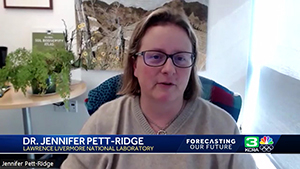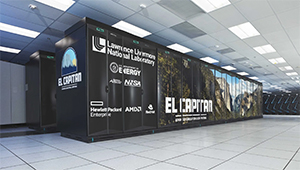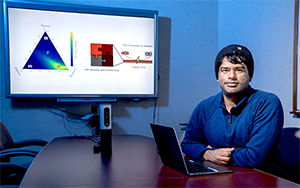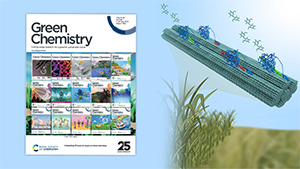LAB REPORT
Science and Technology Making Headlines
March 15, 2024


LLNL’s Jennifer Pett-Ridge discusses findings of the “Roads to Removal” report on a recent news segment on KCRA.
The road to carbon removal
Drastically reducing greenhouse gas emissions is critical to stemming the impacts of human-caused climate change for future generations. “Roads to Removal” is a recent report from Lawrence Livermore National Laboratory that highlights opportunities for the United States to cut carbon by removing CO2 that is already in the air.
“The reality is we have some industries that are very, very difficult to stop all of the emissions,” said Jennifer Pett-Ridge, the lead author of the report.
Pett-Ridge specifically pointed to agriculture, a vital industry for the U.S. and global food supply.
“If we want to feed ourselves, we’re going to get a certain amount of [emissions],” Pett-Ridge said. "That means we need to make up for a certain amount of emissions that we’re not actually able to prevent.”


Hiroshimaites are microscopic glass spheres. Photo courtesy of Nathan Asset/Institut de Physique du Globe de Paris.
A snapshot in time
Studying the conditions in the cloud of gas and dust that birthed our sun and planets is quite difficult. The few bits of information we have often come locked inside ancient materials formed 4.5 billion years ago when the solar system was being born. Those materials look like nothing on Earth — with a few potential exceptions.
In a new study, researchers found that tiny spheres of glass created by the atomic fireball that devastated the Japanese city of Hiroshima during World War II look distinct from most materials formed on Earth. The superhot environment they formed in might instead bear some similarities to the solar nebula from which our sun formed.
“We don’t necessarily have a lot of access to these extreme conditions, and using samples like this is an interesting way of tapping into the conditions that existed in the early solar system,” said Greg Brennecka, a cosmochemist at Lawrence Livermore National Laboratory who wasn’t involved in the study.
“Because they’re the first solids, they represent the first snapshots of what the solar system was built from,” Brennecka said, referring to the fragments. “And they really haven’t changed since then, so you’ve got four and a half billion years of time locked in there.”


El Capitan, the world’s fastest supercomputer, is set to go online later this year. Photo by Garry McLeod/LLNL.
Scaling El Capitan
Rows of tall black cabinets, webbed with multi-colored wires and hoses, lined the computing floor. A clear pane separates visitors. That and another security door, warning of the noise beyond.
Once opened, the whirring was apparent. It was mid-January and the second floor of LLNL’s Computing Center was alive with noise. Contributing to the sound was El Capitan, LLNL’s forthcoming supercomputer, which was undergoing some equipment testing amid functioning systems on the floor.
El Capitan is expected to be the world’s fastest supercomputer, or high-performance computing system, when it becomes operational this year in late summer or early fall.
The system will enable researchers from the National Nuclear Security Administration weapons design laboratories to create models and run simulations, previously considered challenging, time-intensive or impossible, for the maintenance and modernization of the United States’ nuclear weapons stockpile.


LLNL researcher Nitish Govindarajan displays a heatmap showing the effect of the active site type and concentration on the delay time and a schematic summarizing the key findings of this study. Photo by Blaise Douros/LLNL.
Catalysts on tap for CO2 conversion
Intense research efforts have been directed toward studying the electrochemical conversion of CO2, a major greenhouse gas, into platform chemicals and fuels. The success of this technology can enable the decarbonization of some of the largest CO2 emitters, including steel, cement and chemical manufacturing industries.
Copper is unique in its ability to convert CO2 at low temperatures to a diverse range of products, such as carbon monoxide, ethylene and ethanol at industrially viable current densities. As a result, there is widespread interest in understanding CO2 conversion on copper electrodes as efficient and stable CO2 electrolyzers.
In a recent study involving a multi-disciplinary team from Lawrence Livermore National Laboratory (LLNL), Lawrence Berkeley National Laboratory, University of California Berkeley, and the Korea Advanced Institute of Science and Technology (KAIST), researchers used chemical transient kinetics and microkinetic modeling to understand the atomistic-scale workings of copper electrodes during electrochemical conversion of carbon monoxide, a key reaction intermediate in electrochemical CO2 conversion.
“Our surprising finding from this work is that the effective catalytic activity of the reaction improves when there is a larger fraction of less-active sites [termed reservoir sites]. We developed a microkinetic model involving three site types to explain our findings,” said LLNL researcher and co-first author Nitish Govindarajan.


This graphic depicts cellulose that are structural components of plants that are being broken down into simple sugars by enzymes. Graphic by Jennifer Nill.
From residue to sustainable products
A consortium involving Lawrence Livermore has made substantial progress in the development of technologies for converting plant residues into sustainable products.
The research team’s primary focus was to liberate sugars found in plant materials like grasses, weeds, wood and other agricultural byproducts.
The team's findings are expected to lower technological barriers and expedite the sustainable conversion of biomass into valuable products. Consequently, this not only mitigates environmental impact but also steers clear of competition with food supply chains.
Importantly, the research also has potential implications for bio-national security applications, given that the technology can be used for high-throughput characterization of biomolecules in their native state, such as tissues and soil samples.





